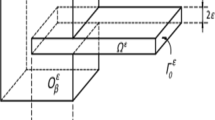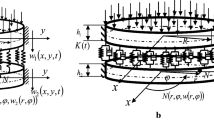Abstract
This paper deals with a variational-based reduced-order model in dynamic substructuring of two coupled structures through a physical dissipative flexible interface. We consider the linear elastodynamic of a dissipative structure composed of two main dissipative substructures perfectly connected through interfaces by a linking substructure. The linking substructure is flexible and is modeled in the context of the general linear viscoelasticity theory, yielding damping and stiffness operators depending on the frequency, while the two main dissipative substructures are modeled in the context of linear elasticity with an additional classical viscous damping modeling which is assumed to be independent of the frequency. We present recent advances adapted to such a situation, which is positioned with respect to an appropriate review that we carry out on the different methods used in dynamic substructuring. It consists in constructing a reduced-order model using the free-interface elastic modes of the two main substructures and, for the linking substructure, an appropriate frequency-independent elastostatic lifting operator and the frequency-dependent fixed-interface vector basis.

Similar content being viewed by others
References
Agrawal BN (1976) Mode synthesis technique for dynamic analysis of structures. J Acoust Soc Am 59:1329–1338
Allen MS, Mayes RL, Bergman EJ (2010) Experimental modal substructuring to couple and uncouple substructures with flexible fixtures and multi-point connections. J Sound Vib 329:4891–4906
Allen MS, Gindlin HM, Mayes RL (2011) Experimental modal substructuring to estimate fixed-base modes from tests on a flexible fixture. J Sound Vib 330:4413–4428
Amsallem D, Farhat C (2011) An online method for interpolationg linear parametric reduced-order models. SIAM J Sci Comput 33:2169–2198
Argyris JH, Kelsey S (1959) The analysis of fuselages of arbitrary cross-section and taper: a DSIR sponsored reserach program on the development and application of the matrix force method and the digital computer. Aircr Eng Aerosp Technol 31:272–283
Argyris J, Mlejnek HP (1991) Dynamics of structures. North-Holland, Amsterdam
Balmes E (1996) Optimal Ritz vectors for component mode synthesis using the singular value decomposition. AIAA J 34:1256–1260
Bathe KJ (1996) Finite element procedures. Prentice-Hall, New York
Bathe KJ, Gracewski S (1981) On non-linear dynamic analysis using substructuring and mode superposition. Comput Struct 13:699–707
Bathe KJ, Wilson EL (1976) Numerical methods in finite element analysis. Prentice-Hall, New York
Bazilevs Y, Takizawa K, Tezduyar TE (2013) Computational fluid-structure interaction. Wiley, Chichester
Belytschko TB, Liu WK, Moran B (2000) Nonlinear finite element for continua and structures. Wiley, Chichester
Benfield WA, Hruda RF (1971) Vibration analysis of structures by component mode substitution. AIAA J 9:1255–1261
Bland DR (1960) The theory of linear viscoelasticity. Pergamon, London
Bourquin F, d’Hennezel F (1992) Numerical study of an intrinsic component mode synthesis method. Comput Methods Appl Mech Eng 97:49–76
Brown AM, Ferri AA (1996) Probabilistic component mode synthesis of nondeterministic substructures. AIAA J 34:830–834
Castanier MP, Tan YC, Pierre C (2001) Characteristic constraint modes for component mode synthesis. AIAA J 39:1182–1187
Chatelin F (2012) Eigenvalues of matrices. Society for Industrial and Applied Mathematics (SIAM), Philadelphia
Clough RW, Penzien J (1975) Dynamics of structures. McGraw-Hill, New York
Craig RR (1985) A review of time domain and frequency domain component mode synthesis method in Combined experimental-analytical modeling of dynamic structural systems. In: Martinez DR, Miller AK (eds) 67 ASME-AMD. New York
Craig RR, Bampton MCC (1968) Coupling of substructures for dynamic analyses. AIAA J 6:1313–1322
Craig RR, Kurdila A (2006) Fundamentals of structural dynamics. Wiley, Chichester
Dautray R, Lions JL (1992) Mathematical analysis and numerical methods for science and technology. Springer, Berlin
de Klerk D, Rixen DJ, Voormeeren SN (2008) General framework for dynamic substructuring: history, review, and classification of techniques. AIAA J 46:1169–1181
El-Khoury O, Adeli H (2013) Recent advances on vibration control of structures and their dynamic loading. Arch Comput Methods Eng 20:353–360
Ewins DJ (2000) Modal testing: theory, practice and applications, 2nd edn. Research Studies Press Ltd., Baldock
Farhat C, Geradin M (1994) On a component mode method and its application to incompatible substructures. Comput Struct 51:459–473
Felippa CA, Park KC, Farhat C (2001) Partioned analysis of coupled mechanical systems. Comput Methods Appl Mech Eng 190:3247–3270
Geradin M, Rixen D (1997) Mechanical vibrations: theory and applications to structural dynamics, 2nd edn. Wiley, Chichester
Guyan RJ (1965) Reduction of stiffness and mass matrices. AIAA J 3:380–380
Hale AL, Meirovitch L (1982) A procedure for improving discrete substructure representation in dynamic synthesis. AIAA J 20:1128–1136
Har J, Tamma K (2012) Advances in computational dynamics of particles, materials and structures. Wiley, Chichester
Herran M, Nelias D, Combescure A, Chalons H (2011) Optimal component mode synthesis for medium frequency problem. Int J Numer Methods Eng 86:301–315
Hinke L, Dohnal F, Mace BR, Waters TP, Ferguson NS (2009) Component mode synthesis as a framework for uncertainty analysis. J Sound Vib 324:161–178
Hintz RM (1975) Analytical methods in component modal synthesis. AIAA J 13:1007–1016
Hong SK, Epureanu BI, Castanier MP, Gorsich DJ (2011) Parametric reduced-order models for predicting the vibration response of complex structures with component damage and uncertainties. J Sound Vib 330:1091–1110
Hughes TJR (2000) The finite element method: linear static and dynamic finite element analysis. Dover, New York
Hurty WC (1960) Vibrations of structural systems by component mode synthesis. J Eng Mech 86:51–69
Hurty WC (1965) Dynamic analysis of structural systems using component modes. AIAA J 3:678–685
Inman DJ (2006) Vibration with control. Wiley, Chichester
Irons B (1965) Structural eigenvalue problems: elimination of unwanted variables. AIAA J 3:961–962
Jezequel L (1985) A hybrid method of modal synthesis using vibration tests. J Sound Vib 100:191–210
Kassem M, Soize C, Gagliardini L (2011) Structural partitioning of complex structures in the medium-frequency range: an application to an automotive vehicle. J Sound Vib 330:937–946
Kuhar EJ, Stahle CV (1974) Dynamic transformation method for modal synthesis. AIAA J 12:672–678
Leung AYT (1993) Dynamic stiffness and substructures. Springer, Berlin
Lim CN, Neild SA, Stoten DP, Drury D, Taylor CA (2007) Adaptive control strategy for dynamic substructuring tests. J Eng Mech 133:864–873
Lindberg E, Horlin NE, Goransson P (2013) Component mode synthesis using undeformed interface coupling modes to connect soft and stiff substructures. Shock Vib 20:157–170
Liu WK, Karpov EG, Park HS (2006) Nanomechanics and materials: theory, multiscale methods and applications. Wiley, Chichester
Liu W, Ewins DJ (2000) Substructure synthesis via elastic media Part I: Joint identification. In: Proceedings of the 18th IMAC Conference on Computational Challenges in Structural Dynamics (IMAC-XVIII). Book Series: Proceedings of The Society of Photo-Optical Instrumentation Engineers (SPIE) Bellingham, vol 4062, pp 1153–1159
MacNeal RH (1971) A hybrid method of component mode synthesis. Comput Struct 1:581–601
Markovic D, Park KC, Ibrahimbegovic A (2007) Reduction of substructural interface degrees of freedom in flexibility-based component mode synthesis. Int J Numer Methods Eng 70:163–180
Meirovitch L (1980) Computational methods in structural dynamics. Sijthoff and Noordhoff, Rockville
Meirovitch L, Hale AL (1981) On the substructure synthesis method. AIAA J 19:940–947
Meirovitch L, Kwak MK (1991) Rayleigh–Ritz based substructure synthesis for flexible multibody systems. AIAA J 29:1709–1719
Mignolet MP, Soize C, Avalos J (2013) Nonparametric stochastic modeling of structures with uncertain boundary conditions/coupling between substructures. AIAA J 51:1296–1308
Morand HJP, Ohayon R (1979) Substructure variational analysis for the vibrations of coupled. Int J Numer Methods Eng 14:741–755
Morand HJP, Ohayon R (1995) Fluid structure interaction. Wiley, Chichester
Morgan JA, Pierre C, Hulbert GM (1998) Calculation of component mode synthesis matrices from measured frequency response functions, part 1: theory. J Vib Acoust 120:503–508
Morgan JA, Pierre C, Hulbert GM (1998) Calculation of component made synthesis matrices from measured frequency response functions, part 2: application. J Vib Acoust 120:509–516
Nobari AS, Robb DA, Ewins DJ (1995) A new approach to modal-based structural dynamic-model updating and joint identification. Mech Syst Signal Process 9:85–100
Oden JT, Reddy JN (2011) An introduction to the mathematical theory of finite elements. Dover, New York
Ohayon R, Soize C (1998) Structural acoustics and vibration. Academic Press, London
Ohayon R, Soize C (2012) Advanced computational dissipative structural acoustics and fluid-structure interaction in low- and medium-frequency domains - Reduced-order models and uncertainty quantification. Int J Aeronaut Space Sci 13:127–153
Ohayon R, Soize C (2013) Structural dynamics in encyclopedia of applied and computational mathematics (EACM). In: Engquist B, Oden JT (eds) Field editor for Mechanics. Springer, New York
Ohayon R, Soize C (2014) Advanced computational vibroacoustics. Cambridge University Press, New York
Ohayon R, Soize C (2014) Clarification about component mode synthesis methods for substructures with physical flexible interfaces. Int J Aeronaut Space Sci. Accepted 13 May 2014
Ohayon R, Sampaio R, Soize C (1997) Dynamic substructuring of damped structures using singular value decomposition. J Appl Mech 64:292–298
Park KC, Park YH (2004) Partitioned component mode synthesis via a flexibility approach. AIAA J 42:1236–1245
Perdahcioglu DA, Geijselaers HJM, Ellenbroek MHM, de Boer A (2012) Dynamic substructuring and reanalysis methods in a surrogate-based design optimization environment. Struct Multidiscip Optim 45:129–138
Philippe B, Sameh A (2011) Eigenvalue and singular value problems 608–615 Encyclopedia of parallel computing. In: Padua D (ed) Springer, Berlin
Przemieniecki JS (1963) Matrix structural analysis of substructures. AIAA J 1:138–147
Reynders E (2012) System identification methods for (operational) modal analysis: review and comparaison. Arch Comput Methods Eng 19:51–124
Rixen DJ (2004) A dual Craig-Bampton method for dynamic substructuring. J Comput Appl Math 168:383–391
Rubin S (1975) Improved component-mode representation for structural dynamic analysis. AIAA J 13:995–1006
Saad Y (2011) Numerical methods for large eigenvalue problems. Society for Industrial and Applied Mathematics (SIAM), Philadelphia
Sanchez-Hubert J, Sanchez-Palencia E (1989) Vibration and coupling of continuous systems: asymptotic methods. Springer, Berlin
Sarkar A, Ghanem R (2003) A substructure approach for the midfrequency vibration of stochastic systems. J Acoust Soc Am 113:1922–1934
Soize C (2012) Stochastic models of uncertainties in computational mechanics. American Society of Civil Engineers, Reston
Soize C, Batou A (2011) Stochastic reduced-order model in low-frequency dynamics in presence of numerous local elastic modes. J Appl Mech 78:061003-1–061003-9
Soize C, Chebli H (2003) Random uncertainties model in dynamic substructuring using a nonparametric probabilistic model. J Eng Mech 129:449–457
Soize C, Mziou S (2003) Dynamic substructuring in the medium-frequency range. AIAA J 41:1113–1118
Soize C, Poloskov IE (2012) Time-domain formulation in computational dynamics for linear viscoelastic media with model uncertainties and stochastic excitation. Comput Math Appl 64:3594–3612
Suarez LE, Singh MP (1992) Improved fixed interface method for modal synthesis. AIAA J 30:2952–2958
Truesdell C (1984) Mechanics of solids, Vol III, theory of viscoelasticity, plasticity, elastic waves and elastic stability. Springer, Berlin
Tu JY, Yang HT, Lin PY, Chen PC (2013) Dynamics, control and real-time issues related to substructuring techniques: application to the testing of isolated structure systems. J Syst Control Eng 227:507–522
Urgueira APV (1989) Dynamic analysis of coupled structures using experimental data. Thesis of the University of London for the Diploma of Imperial College of Science, Technology and Medecine. London
Voormeeren SN, van der Valk PL, Rixen DJ (2011) Generalized methodology for assembly and reduction of component models for dynamic substructuring. AIAA J 49:1010–1020
Zienkiewicz OC, Taylor RL (2005) The finite element method for solid and structural mechanics, 6th edn. Butterworth-Heinemann, Amsterdam
Acknowledgments
This research was partially supported by Brazil-France project CAPES-COFECUB Ph672/10.
Author information
Authors and Affiliations
Corresponding author
Rights and permissions
About this article
Cite this article
Ohayon, R., Soize, C. & Sampaio, R. Variational-Based Reduced-Order Model in Dynamic Substructuring of Coupled Structures Through a Dissipative Physical Interface: Recent Advances. Arch Computat Methods Eng 21, 321–329 (2014). https://doi.org/10.1007/s11831-014-9107-y
Received:
Accepted:
Published:
Issue Date:
DOI: https://doi.org/10.1007/s11831-014-9107-y




